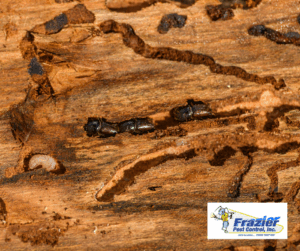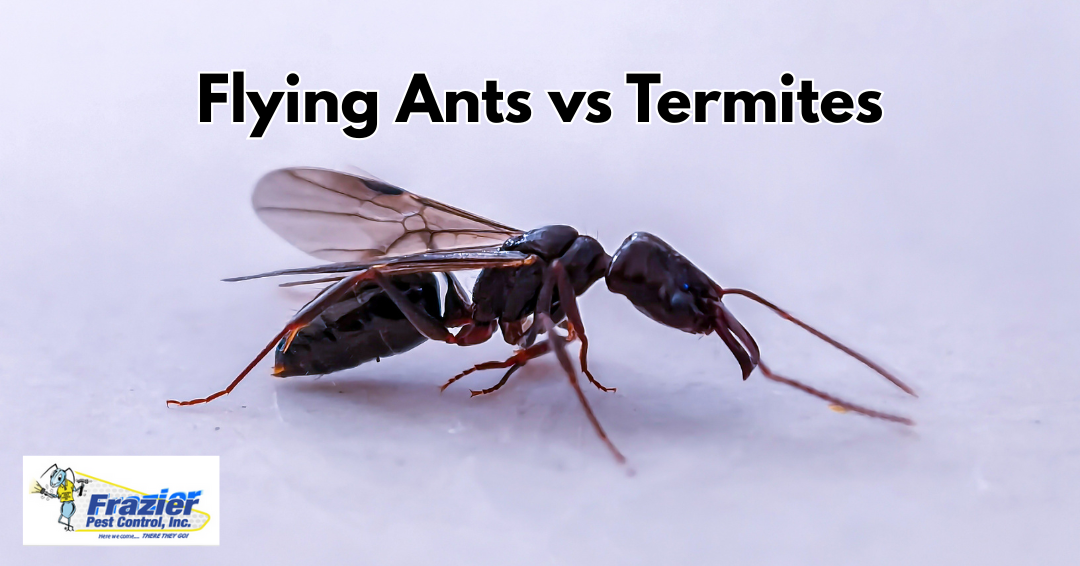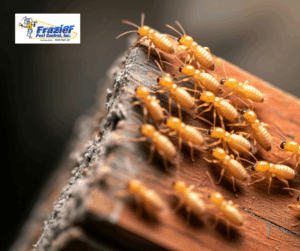Every spring and summer, homeowners across the Coachella Valley, Inland Empire, and Morongo Basin ask the same question: flying ants vs termites — how can you tell the difference? Both pests swarm during warm months, both have wings, and at first glance, they look almost identical. But knowing whether you’re dealing with flying ants or termites is critical, because termites can cause serious and costly structural damage if not identified quickly.
At Frazier Pest Control, we often get calls from worried homeowners asking: “Do I have flying ants or termites?” Knowing the difference could save your home from serious damage.
Read more: Why Subterranean Termites Often Go Undetected in Coachella Valley Homes
Why Flying Ants and Termites Look So Similar
Both flying ants and termites swarm during warm months to reproduce and start new colonies. Because they’re both small, dark-colored, and winged, it’s easy to confuse one for the other. Unfortunately, mistaking termites for ants can delay treatment — and give termites time to silently destroy wood inside your home.
 Key Differences Between Flying Ants and Termites
Key Differences Between Flying Ants and Termites
Here’s how to spot the difference:
1. Body Shape
- Flying Ants: Narrow “waist” between body segments, similar to a wasp.
- Termites: Thick, straight body with no visible waist.
2. Antennae
- Flying Ants: Elbowed or bent antennae.
- Termites: Straight, beaded antennae.
3. Wings
- Flying Ants: Two pairs of wings of different lengths (front wings larger). Wings are angled upward when at rest.
- Termites: Two pairs of wings that are the same length. Wings lie flat and break off easily.
4. Behavior
- Flying Ants: May appear indoors, but don’t cause structural damage.
- Termites: Found near wood, soil, or moisture sources — and are capable of causing costly damage if not treated quickly.
Read more: Mice in Coachella Valley Homes: Signs, Risks, and Removal
Why It Matters If They’re Termites
 Flying ants can be a nuisance, but they don’t threaten the structure of your home. Termites, on the other hand, eat cellulose in wood. Over time, this can weaken floors, walls, and even the foundation of your home.
Flying ants can be a nuisance, but they don’t threaten the structure of your home. Termites, on the other hand, eat cellulose in wood. Over time, this can weaken floors, walls, and even the foundation of your home.
In the Coachella Valley, drywood termites are especially common. These pests can infest attics, furniture, and wall voids — often without being noticed until damage is extensive.
Read more: Argentine Ants in the Coachella Valley: The Unstoppable Invasion
What to Do If You See Swarming Insects in Your Home
If you notice flying ants or termites, here’s what to do right away:
- Collect a sample: If possible, catch one of the insects in a clear container to show a pest professional.
- Look for other signs: Termites leave behind discarded wings, hollow-sounding wood, and small piles of droppings.
- Call a professional: Only a trained technician can confirm whether you’re dealing with flying ants or termites — and recommend the right treatment.
Read more: Pest Control in Coachella Valley: Why Professional Services Matter for Your Property’s Safety
Trusted Termite and Ant Control in the Coachella Valley
At Frazier Pest Control, our licensed technicians know how to identify flying ants versus termites quickly and accurately. If it’s ants, we’ll help you eliminate them. If it’s termites, we’ll design a targeted treatment plan to stop the infestation before it causes major damage.
Don’t take chances with your biggest investment — your home. If you see swarming insects inside or around your house, call Frazier Pest Control today for a professional inspection.
Read more: Why Squishing Ants Can Make Your Infestation Worse
FAQ: Flying Ants vs Termites
Q: Do flying ants eat wood like termites?
A: No. Flying ants don’t damage wood. They may be annoying indoors, but they don’t threaten the structure of your home. Termites, on the other hand, feed on cellulose and can cause severe damage over time.
Q: How long do termite swarms last?
A: Termite swarms are usually short-lived, lasting 30 to 40 minutes. However, the presence of swarmers means an active colony is nearby and requires professional treatment.
Q: Are termite wings different from ant wings?
A: Yes. Termite wings are equal in length and easily shed, often leaving piles of discarded wings near windows or baseboards. Ants have uneven wing lengths and typically keep their wings intact.
Q: How do I know if I have drywood termites in the Coachella Valley?
A: Drywood termites often leave behind tiny piles of droppings, called frass, that look like sawdust or coffee grounds. If you notice this near wood structures, call for an inspection immediately.
Q: What should I do first if I can’t tell whether it’s ants or termites?
A: Don’t wait to find out on your own. Collect a sample if you can, and contact a professional pest control company like Frazier. Quick identification is the key to preventing expensive damage.


 Key Differences Between Flying Ants and Termites
Key Differences Between Flying Ants and Termites
Recent Comments